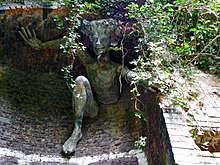 | |
| Grouping | Mythological creature Fairy Sprite |
|---|---|
| Country | England |
| Region | Cornwall |
A spriggan /sprɪdʒən/ is a legendary creature from Cornish folklore. Spriggans are particularly associated with West Penwith in Cornwall.
Etymology
Spriggan is a dialect word, pronounced with the grapheme <gg> as /d͡ʒ/, sprid-jan, and not sprigg-an, borrowed from the Cornish plural spyrysyon 'spirits'.
In folklore
Spriggans have often been depicted as grotesquely ugly, wizened old men with large childlike heads. They were said to be found at old ruins, cairns, and barrows guarding buried treasure. Although small in stature, they have often been considered to be the ghosts of giants and retained gigantic strength, and in one story collected by Robert Hunt, they showed the ability to swell to enormous size. Hunt associated these spirits with the hillfort known as Trencrom Hill in Cornwall.
Spriggans were notorious for their unpleasant dispositions, and delighted in working mischief against those who offended them. They raised sudden whirlwinds to terrify travellers, sent storms to blight crops, and sometimes stole away mortal children, leaving their ugly changelings in their place. They were blamed if a house was robbed or a building collapsed, or if cattle were stolen. In one story, an old woman got the better of a band of spriggans by turning her clothing inside-out (turning clothing supposedly being as effective as holy water or iron in repelling fairies) to gain their loot.
On Christmas Eve, spriggans met for a midnight Mass at the bottom of deep mines, and passersby could hear them singing. However, it was not spriggans but the buccas or knockers who were associated with tin mining, and who played a protective role towards the miners.
Based on the collections of Robert Hunt and William Bottrell, Katharine Briggs characterized the spriggans as fairy bodyguards. The English Dialect Dictionary (1905) compared them to the trolls of Scandinavia.
Sculpture
A sculpture of a spriggan by Marilyn Collins can be seen in Crouch End, London, in some arches lining a section of the Parkland Walk (a disused railway line). The sculpture was installed in 1993. If walking along the Parkland Walk from Finsbury Park to Highgate station, the Spriggan is to the right just before the disused railway platforms of the former Crouch End station. To the left, on the southside of the Parkland Walk is Crouch Hill Park where Ashmount School has been located since January 2013. The sculpture is sometimes mistaken for the Green Man or Pan.
In popular culture
Spriggans have been featured as fey creatures in the Dungeons & Dragons roleplaying game since the 1980s.
Additionally, spriggans – in the style of the Parkland Walk sculpture – can be found in The Elder Scrolls series of video games and they are portrayed as females.
In the Beyblade Burst series, the character Shu Kurenai owns a Spriggan Beyblade, represented by a red oni. In the English dub and Hasbro releases however, the Beyblade had its name changed to Spryzen.
In the video game World of Warcraft, the Spriggan are a race of fae loyal to the Drust, a dark and twisted version of the fae.
In the Sword Art Online series, the Spriggans are one of the nine races in ALfheim Online, known to have a darker skin tone compared to the other races and are typically associated with the color black.
In the video game series Legend of Heroes: Trails Through Daybreak I and II, Van Arkride describes himself as a spriggan. In the context of the games, it means someone who is willing to take on shady or illegal tasks for a price.
See also
Citations
- Various folklore collections e.g. Craig Weatherhill and Paul Devereux, Myths and Legends of Cornwall, 1994, p. 23, Sigma Leisure, ISBN 978-1850583172
- Dr Ken George, An Gerlyver Meur, p. 600, Cornish Language Board, ISBN 978-1902917849
- ^ Piskies, Spriggans, Knockers, and the Small People – Traditional Tales from Cornwall. Truro: Tor Mark Press. c. 1979. p. 2. ISBN 978-0850250435.
- Robert Hunt, Popular Romances of the West of England, 3rd edition, 1916, p. 81, ISBN 978-1605064604
- ^ Wright, Joseph, ed. (1905). The English Dialect Dictionary. Vol. V. Henry Frowde. p. 690.
- Robert Hunt, Popular Romances of the West of England, 3rd edition, 1916, The Old Woman Who Turned Her Shift, page 113-114
- Robert Hunt, Popular Romances of the West of England, 3rd edition 1916, page 349
- Robert Hunt, Popular Romances of the West of England, 3rd edition, 1916, page 82
- Briggs, Katharine (1976). A Dictionary of Fairies. Penguin. pp. 300, 380–381. ISBN 978-0140176582.
- Collins, Marilyn. "Marilyn Collins". Retrieved 10 August 2020.
General sources
- Briggs, Katharine. A Dictionary of Fairies. Penguin, 1976, ISBN 978-0140176582
- Underground History: "The Northern Heights", Hywel Williams. Accessed 8 July 2007.
| Culture of Cornwall | |||||
|---|---|---|---|---|---|
| Cornish: Gonisogeth Kernow | |||||
| Symbols |  | ||||
| Festivals | |||||
| Sports | |||||
| Cuisine | |||||
| Arts | |||||
| Music |
| ||||
| Language | |||||
| Mythology | |||||
| Organisations | |||||